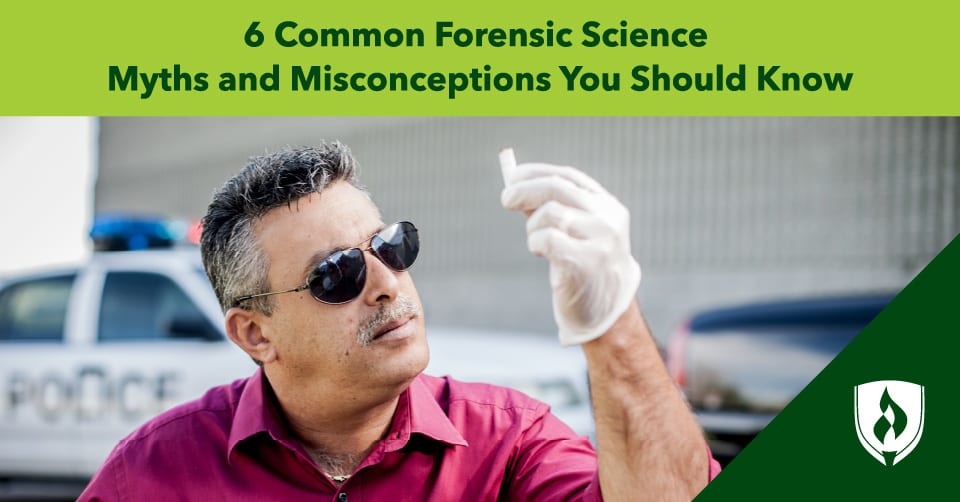
You’ve seen it play out before in popular media. There’s a single human hair out of place at the crime scene, and a high-profile case depends on it. Others might overlook it, but the meticulous forensics specialist carefully places it into a glass tube with a look of triumph on their face—they know this tiny hair is the key to cracking the case. Soon, the bad guy will be behind bars, and the ace team of investigators will move on to their next blockbuster case.
Sounds pretty great, huh? If only it were true.
Unfortunately, the real world of forensics is not this simple. Pop culture portrayals of criminal investigations have helped fuel several misconceptions and myths about forensic science and the day-to-day work of these law enforcement specialists.
If you could use a little more “true” in your understanding of true crime, keep reading. After you learn what forensic science is really like, you might appreciate the work even more than before.
Under the microscope: 6 forensic science myths explored
1. One tiny piece of evidence is always going to be the key to solving the case
For Sherlock Holmes® in his fictional world, a single mote of dust from a factory down the road could unlock the entire case. But pieces of evidence, even when pristine, rarely add up to large results on their own.1 More often, forensic scientists provide findings that corroborate other elements of an investigation.
On top of that, finding a quality piece of evidence is much harder than TV would lead you to believe. Evidence contamination is a serious issue—and criminal defense teams use this to build reasonable doubt in the minds of jurors. DNA samples go through multiple steps of handling that risk contamination to the point of becoming unusable.2
Evidence found at a scene is often exposed to environmental factors like weather, passersby and even the material the evidence fell on (such as blood soaking into a dirty carpet). These elements make biological evidence much harder to work with.
2. Forensic scientists don’t have to deal with people
Many assume a lab role like forensic science means they don’t need to work with people as often—or that they are shielded from the high-intensity aspects of the legal world. That’s far from the truth. Forensic scientists are team players who work with other forensic scientists, detectives, district attorneys and more on a regular basis.
They also need to testify in court. High-pressure, probing cross-examinations are a part of the job as defense teams look to challenge your findings. Forensic professionals must hold up well in the face of scrutiny, speak carefully and learn to convey results in an easily understandable way.
3. They work in pristine, sterile environments
Typically, a lab is one of the cleanest places most people picture when they think of a work environment. That is certainly true for part of the job when forensic scientists have the chance to work on contained elements.
But forensic teams may need to collect evidence in outdoor locations or crime scenes a distance away from their labs. Environments might have hazards, and evidence might involve some exposure to diseases or chemicals. There might be strange smells and bugs. In fact, there’s a whole niche branch of forensic science (forensic entomology) dedicated to the insect activity that appears in corpses after death, which can help scientists understand where and when someone died.
Needless to say, the work is often much messier than you might imagine.
4. Forensics specialists are their own boss in the lab
Loads of TV shows and movie portrayals make forensic scientists appear pretty autonomous in their work. Detectives might pop in to badger them to hustle something along, but mostly, they get into their groove and get to lose themselves in the work.
In reality, most forensic scientists have lots of variation and unpredictability in their job each day. If there’s a high-profile case or a sudden breakthrough, forensic scientists can see their workload shift around in the blink of an eye.
5. DNA testing is a routine, speedy and infallible process
DNA testing has been in the public mind for long enough that it might seem like a finely tuned machine at this point. But the complicated process of DNA testing can actually take days or even weeks—and human error can still spoil the result.
Since DNA testing isn’t always as reliable as people tend to think, forensic scientists need to work with extreme care and remain skeptical of even their own results. A mistake can lead to incredibly damaging consequences as wrongful convictions and faulty acquittals ruin lives.
6. The job is all test tubes and microscopes
TV shows sure make it look like forensic scientists spend the entirety of their days doing stereotypically “science-y” things like peering into microscopes and examining test tubes of mystery substances. While the hands-on science aspects of this job are certainly important, forensic scientists often spend a great deal of time doing paperwork, entering data and double and triple-checking equipment, chemicals, supplies and anything else that could compromise the results of their work.
Whether it’s poor documentation, faulty equipment or bad processes, if there’s anything below standard in the lab forensics, professionals risk the possibility of important case information being disqualified. Forensic scientists are meticulous about keeping high-quality standards and documenting everything they do.
Looking further into the real-life legal world
As you can see, while forensic science is not as fast or as clear as a good episode of TV might make it seem, it’s every bit as fascinating. Forensic scientists have made important discoveries from flecks of pollen, the smells of certain gasses, bitemarks and so many other things that involved careful observation and meticulous science.
If you love breaking down parts of criminal investigations and seeing how the various legal professionals involved really work, get a look at a different legal career at “What I Wish I Knew Before Becoming a Paralegal.”
Related Articles:
1Jonathan Koehler, “How Trial Judges Should Think About Forensic Science Evidence” Judicature, Bolch Judicial Institute Duke Law School, Spring 2018. [accessed September 2022] https://judicature.duke.edu/articles/how-trial-judges-should-think-about-forensic-science-evidence/
2Carly Balk, “Reducing Contamination in Forensic Science” Themis: Research Journal of Justice Studies and Forensic Science, Spring 2015. [accessed September 2022]
Sherlock Holmes is a registered trademark of Conan Doyle Estate LTD.




